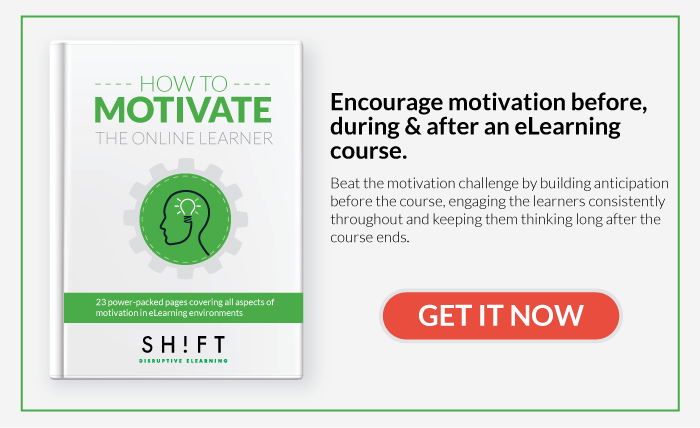Overwhelmed by the challenge of crafting engaging e-learning courses? Always searching for ways to make the material more appealing without sacrificing quality or time?
We totally get those challenges. Creating courses that are not only informative but also encourage retention can feel daunting.
In a world where attention is a prized commodity and the demand for online content grows every day, vying for learners' focus is fiercer than ever. But here's where a powerful tool comes into play: animations.
In the context of eLearning, animations are like flashes of creativity turning static concepts into moving visual narratives. They're the brushstrokes of life that can revolutionize how learners engage with your content.
Exploring the Different Types of Animations
Before diving into how to effectively use animations in your courses, it's crucial to understand the various types available and how they can breathe life into your content:
-
Transition Animations: These subtle visuals craft a seamless flow, connecting different parts of your course. A well-executed transition can ease shifts, keeping learners on track and confusion at bay.
-
Illustration Animations: Imagine having moving images, words, and icons. Illustrated animations do just that, turning abstract concepts and plain text into lively and dynamic images, making content a visual feast.
-
Interactive Animations: These turn learners into active participants, allowing them to explore content and make choices. This interaction fosters a deeper bond with the material and enhances immersion.
-
Data Animations: Drowning in a sea of numbers? Data animations bring these figures to life, turning them into animated charts that tell a visual story.
Using Animations Effectively in eLearning Courses
Now that we've addressed the heart of animations, let's delve into how they can significantly elevate your eLearning courses:
-
Conceptual Simplicity: Animations have the unique ability to transform complex ideas into visually digestible sequences. By breaking down intricate concepts into straightforward visual steps, animations provide learners with a more intuitive and clearer understanding. It's essential to remember that the underlying principle in this process should always be simplicity.
-
Visual Storytelling: Animations shouldn't stand alone; they should form part of a consistent, engaging narrative that effectively addresses and reinforces specific learning objectives. Think of your animation as a visual story, guiding the learner through a journey.
-
Strategic Emphasis: Have certain pivotal ideas or points that you need learners to focus on? Use animations as a spotlight, directing attention precisely where it's needed. This strategic emphasis can ensure that crucial concepts are not just seen but are truly understood and retained.
-
Avoiding Overload: While animations can be powerful tools, they can also become counterproductive if overused. A fundamental guideline for integrating animations into eLearning is practicing moderation. Consider animations as delicate brushstrokes in a painting – they should enhance and clarify, not clutter or confuse. Ensure each animation has a purpose, and avoid the temptation to animate for animation's sake. In doing so, you'll strike the right balance between static content and dynamic visuals, creating a harmonious learning environment."
Getting Creative: Ideas for Impactful Animation
Tapping into your creative wellspring can lead to transformative results, especially when integrating animations into your educational content. They have the potential to captivate, explain, and engage in ways that static visuals often can't.
Here's a deeper dive into some innovative strategies to elevate your e-learning experience:
-
Detailed Process Illustrations: Instead of lengthy textual descriptions, use animations to break down complex processes into easily understandable, step-by-step visual guides. This can be especially useful for technical or intricate topics where showing is more effective than telling.
-
Contrast through Visual Comparisons: Highlight the distinctions between two concepts, products, or ideas using animations. By showcasing side-by-side animated comparisons, you can make differences and similarities more palpable and memorable to the learner.
-
Bringing Infographics to Life: Static infographics can be information-rich, but animating them adds an extra layer of engagement. Animated infographics can guide the viewer's eye, emphasize key points, and make the information flow feel more natural and intuitive.
-
Illuminating Abstract Ideas: Some concepts are challenging to convey through words alone. Animations offer a solution by turning abstract notions into visual stories or metaphors, making them more relatable and easier to grasp.
-
Engaging Microlearning Clips: The digital age has reshaped attention spans. By creating short, focused animated videos, you cater to this new age of learners. These clips can emphasize key takeaways, serve as revision aids, or introduce new topics in a bite-sized, engaging manner.
-
Interactive Data Visualization: In a world drowning in data, make your numbers stand out. Instead of static charts or tables, use animations to bring data to life, highlighting trends, illustrating changes over time, and making statistics more accessible and meaningful.
Embracing the Future of Visual Learning
In the ever-evolving landscape of e-learning, animations emerge not merely as decorative tools but as catalysts for profound understanding. They bridge the gap between abstract concepts and tangible comprehension, inviting learners into a realm where information becomes an experience. As educators and content creators, it's essential to recognize this transformative potential and harness it thoughtfully.
Let's pause and reflect: How can we push the boundaries of traditional learning? How might we leverage the power of animations to not only educate but inspire? In weaving animation into our educational tapestry, we are presented with an opportunity to challenge conventions, to spark curiosity, and to create lasting impacts in the minds of learners.
Training leaders, animations might be the magic touch your eLearning courses need. With SHIFT AI technology, you can now craft animations in minutes using our APEX animation generation engine. Imagine adding that dynamic flair to your content without the hassle or long processes.
APEX simplifies and speeds up animation creation, freeing you up to focus on impactful course design. Interested in this innovation? Feel free to reach out for more details and experience firsthand how APEX can transform your eLearning courses.



